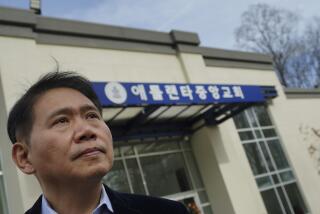For Korean American family, an ache 37 years long
One night in August, after his wife and 2-month-old boy had long fallen to sleep, Steve Inman got to thinking about family and heredity. With a rare moment to himself, he pulled a box of photo albums out of the hall closet at his home in Fontana.
He found an old picture of himself as a boy and laughed at how he and his son had the same round ears and the funny top lip that flipped up like the bow of a ship. He perused faded images of his mother as a young woman in South Korea, and then came across his oldest sister, sitting in a meadow before he was born.
She was about 8 months old then and had the same cast to her face as his boy, the same squint.
Seeing her in his own first child, he felt an overwhelming rush of sadness, a sense he had let her down. She had been missing for 37 years now. Although he had never even met her, it hit him how much a part of him she was.
He wondered if she was still alive.
::
How Sally disappeared was never quite clear to Steve.
He was told his father, Steve Sr., was stationed with the Army in Korea when he married his mother, Chum Ku Yi. When she went into labor with Sally, they couldn’t get to the base hospital in time, and the baby was born at a house in the village of Chang-mal. The couple raised her for about eight months in Korea with the help of a nanny, an old woman they knew.
The Inmans were set to move to America, but the U.S. and Korean authorities would not approve documents stating that Steve Sr. was Sally’s father. So they left her with her grandmother while they went back to Steve’s hometown, Salt Lake City, to work out the problem.
Growing up, the younger Steve was told his parents got a call one day from the grandmother, who said Sally’s nanny had come to visit because she missed the little girl and wanted to take her for a few days. The old woman never returned. Sally was gone.
In America, the Inmans were having problems. He wasn’t making much money and was drinking, and they didn’t have the means to go to Korea to look for the little girl. Chum gave birth to a girl, Connie, then to Steve. A few months after Steve was born, their father left them.
Chum remarried, settled with the two children in California and went to Korea several times, ostensibly looking for Sally. She came up with nothing.
The girl’s absence haunted the family. “Sally should be here,” an uncle would say at Christmas dinner.
Framed pictures of her sat on top of the television and hung in the hallway of their home in Fullerton. In an album, there was a photo of the nanny. Steve and Connie saw evil in her face.
Connie always felt the ache of something missing, as if she was homesick even when she was home. Steve worried about what might have befallen Sally. Was she an orphan, homeless?
When the Internet began to flourish, he occasionally typed her name into search engines. But then, he thought, the nanny probably changed it. He sent e-mails to news stations, trying to gin up interest, but never got a response. A private investigator told him it would cost $30,000 just to start. Steve wrote to Oprah, knowing how she liked reuniting people.
::
That night in August, Steve, then 33, resolved to try again. But how? He didn’t know where to start.
He decided to create a Facebook profile for “Sally Inman (missing child).” He posted 12 photos of her and wrote that she had been abducted.
Nothing happened. He became lost in his work, editing video of mixed martial arts fighting and raising Miyka, the baby boy he had with his wife, Donya. The day after New Year’s, he was relaxing, watching the Food Network, when his cellphone rang. Not recognizing the number, he let it go straight to voicemail.
He waited for the voicemail to finish, then listened.
“Steve, I was on Facebook and I noticed you were looking for your sister and I read the whole thing . . .” Her voice sounded faintly Southern. “And I would like you just to give us a call because the girl you’re looking for is actually my mom.”
He was suspicious. He suspected it was a prank.
He called back anyway.
“Hold on, let me get my mom,” the girl said.
His heart was beating hard.
“Is this Steve? This is Sally,” a woman said, also with a Southern twang.
Steve could barely speak. No way, he kept thinking. This is a scam.
“I have those same pictures,” the woman said.
“Well, umm.” Steve struggled for words. “Maybe we could take a paternity test.”
“I know who I am,” she said, sounding annoyed. “I don’t need a paternity test.”
They went back and forth, not really saying anything, as Steve’s mind raced through the possibilities.
“Well, my mom would know it’s me,” the woman said, “because I have a birthmark on my lip.”
Steve dropped the phone. His mother had told him this before. This must be Sally.
“I’m going to call you right back,” he told her.” I need to call my mom.”
::
That afternoon in Lillington, N.C., Sally Blue had asked one of her daughters, Candace, to type her birth name into Facebook.
Sally learned she had been adopted when she was 9.
Her adoptive mother, Chun, told Sally that her biological parents could not bring her to the United States, because her blood type didn’t match one of them. Chun’s mother was Sally’s nanny and took care of her when the parents left. The Inmans sent money and letters but eventually stopped. The nanny was too old to raise her, so Chun and her American husband decided to adopt her.
They moved to Texas when Sally was 3.
She was an only child and always wondered about her blood parents.
Whenever she got in trouble, Chun told her she was “wild, just like your father.”
She saw how close her friends were to their parents, and wondered why her mother was so strict and distant. Was it the cultural gap? Or was it because she wasn’t really hers? When Sally would go to the doctor, she could never fill out any of the questions about family medical history.
When she had children, her curiosity grew. She learned her blood type was O positive, not A positive, as she had been told all her life.
Chun had told her the names of her real parents, and occasionally she sought them out on the Internet but found nothing.
This was the first time she had tried Facebook. Her daughter pulled up a screen.
There was her baby picture. “Oh my God, that’s me,” Sally said, starting to cry. She couldn’t believe her family was looking for her. She didn’t know she had a brother and a sister.
She saw Steve’s number at the bottom of the screen.
She stood looking at it for 10 minutes, paralyzed.
“Are you going to call, Mom?”
“Candace, you do it.”
Sally was spinning. She desperately wanted to talk to her lost family. But these people thought she had been kidnapped. Were they going to go after her parents now?
::
Connie and her mother raced to Steve’s house when they heard the news. Steve called Sally back on speaker phone, and they all talked and cried.
“I’m sorry, I’m sorry,” their mother sobbed. “I don’t know what happened. I’m sorry that 37 years went by. I thought you were eating out of a trash can. I’m so glad you’re alive.”
Sally’s husband bought a webcam at Wal-Mart so they could see each other on Skype. Sally showed them the same photo that inspired Steve to look for her, then a photo of herself when she was 5.
It was surreal. In Steve’s mind, Sally was always a baby. Seeing her at 5 somehow helped him make the leap from that old photo to the woman before him.
Connie, 36, and Sally, 38, kept staring at each other through the computer screens, studying each other’s faces and mannerisms. Each of them had their legs folded and their heads tilted onto one hand. They could be twins. They both talked fast and had the same quick wit and laugh.
“It was like looking in a mirror,” said Sally.
::
Connie and Steve helped pay to fly Sally and three of her seven children to Southern California three days later. Their father flew in from Colorado. They rarely left Steve’s house for a week, just talking, comparing notes about their childhoods, ribbing one another.
Sally felt as if she had been robbed of 37 years. She was the older sister. She should have been there for their graduations, their weddings, their children’s births.
They all tried to piece together what had happened in South Korea in 1974, a time when the mixed-race children of American soldiers and Korean women were deeply stigmatized.
Steve Sr. told Sally that he and her mother were not married when she was born, and that the U.S. Embassy tried to make him go through the expensive process of adopting her to bring her to the U.S. He was just a 21-year-old soldier with no money and wasn’t about to adopt his own daughter.
Her mother, however, told her they were married and tried everything to get her out of the country.
Steve and Connie didn’t know what to think anymore. Their image of the evil nanny blurred. The woman was dead, and they’d probably never know what she did, good or bad.
Sally wasn’t sure if she wanted to have the questions answered. Had her biological parents really come looking for her? Or did they give up? How exactly did she end up with the nanny? And if the parents who raised and loved her had truly kidnapped her, why would they tell her about the adoption and her biological parents?
Her newfound parents felt like strangers.
But it was as if she had always known her brother and sister.
When Connie came down with laryngitis, Sally joked that, thank god, now the rest of them could finally talk. She even told Connie and Steve — older sister-like — to settle down when they started to bicker while ordering food one night. “I’ll whip both of your asses,” she quipped.
Now they talk every day, wishing they lived closer. They’re still reconfiguring their perceptions of what happened so long ago.
The questions linger. But they’re not letting that get in the way. Steve, Connie and their mother are flying to North Carolina next week.
More to Read
Start your day right
Sign up for Essential California for news, features and recommendations from the L.A. Times and beyond in your inbox six days a week.
You may occasionally receive promotional content from the Los Angeles Times.







